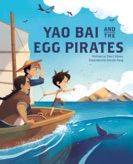Yao Bai and the Egg Pirates
by Tim J. Myers:
CA standards it meets
History/social studies standards first to fourth grade:
1.1.1 Students describe the rights and individual responsibilities of citizenship.
2 Understand the elements of fair play and good sportsmanship, respect for the rights and opinions of others, and respect for rules by which we live, including the meaning of the “Golden Rule.”
1.1.2 Students compare and contrast the absolute and relative locations of places and people and describe the physical and/or human characteristics of places.
4--Describe how location, weather, and physical environment affect the way people live, including the effects on their food, clothing, shelter, transportation, and recreation.
1.3 Students compare and contrast everyday life in different times and places around the world and recognize that some aspects of people, places, and things change over time while others stay the same.
2--Study transportation methods of earlier days.
3--Recognize similarities and differences of earlier generations in such areas as
work (inside and outside the home), dress, manners, stories, games, and festivals,
drawing from biographies, oral histories, and folklore.
Students describe the human characteristics of familiar places and the varied backgrounds of American citizens and residents in those places.
1.Recognize the ways in which they are all part of the same community, sharing principles, goals, and traditions despite their varied ancestry; the forms of diversity in their school and community; and the benefits and challenges of a diverse population.
2.Understand the ways in which American Indians and immigrants have helped define Californian and American culture.
3.Compare the beliefs, customs, ceremonies, traditions, and social practices of the varied cultures...
2.4 Students understand basic economic concepts and their individual roles in the economy and demonstrate basic economic reasoning skills.
1.Describe food production and consumption long ago and today, including the roles of farmers, processors, distributors, weather, and land and water resources.
2.Understand the role and interdependence of buyers (consumers) and sellers (producers) of goods and services.
3.Understand how limits on resources affect production and consumption (what to produce and what to consume).
3.2.5 Students understand the importance of individual action and character and explain how heroes from long ago and the recent past have made a difference in others’ lives
3.1 Students describe the physical and human geography and use maps, tables, graphs, photographs, and charts to organize information about people, places, and environments in a spatial context.
1.Identify geographical features in their local region (e.g., deserts, mountains, valleys, hills, coastal areas, oceans, lakes).
2.Trace the ways in which people have used the resources of the local region and modified the physical environment (e.g., a dam constructed upstream changed a river or coastline).
3.3 Students draw from historical and community resources to organize the
sequence of local historical events and describe how each period of settlement left
its mark on the land.
1.Research the explorers who visited here, the newcomers who settled here, and the people who continue to come to the region, including their cultural and religious traditions and contributions.
2.Describe the economies established by settlers and their influence on the present-day economy, with emphasis on the importance of private property and entrepreneurship.
3.Trace why their community was established, how individuals and families contributed to its founding and development, and how the community has changed over time…
3.5 Students demonstrate basic economic reasoning skills and an understanding of the economy of the local region.
1.Describe the ways in which local producers have used and are using natural resources, human resources, and capital resources to produce goods and services in the past and the present.
4.4.4 Students explain how California became an agricultural and industrial power, tracing the transformation of the California economy and its political and cultural development since the 1850s.
5.Discuss immigration and migration to California between 1850 and 1900, including the diverse composition of those who came; the countries of origin and their relative locations; and conflicts and accords among the diverse groups (e.g., the 1882 Chinese Exclusion Act).
4.3 Students explain the economic, social, and political life in California from the establishment of the Bear Flag Republic through the Mexican-American War, the Gold Rush, and the granting of statehood.
1.Compare how and why people traveled to California and the routes they traveled
2.Analyze the effects of the Gold Rush on settlements, daily life, politics, and the physical environment (e.g., using biographies of John Sutter, Mariano Guadalupe Vallejo, Louise Clapp).
4.4 Students explain how California became an agricultural and industrial power, tracing the transformation of the California economy and its political and cultural development since the 1850s.
2--Explain how the Gold Rush transformed the economy of California, including the types of products produced and consumed, changes in towns (e.g., Sacramento, San Francisco), and economic conflicts between diverse groups of people.
4--Describe rapid American immigration, internal migration, settlement, and the growth of towns and cities (e.g., Los Angeles).
--Fourth-grade language arts standards:
“...a critical transition from learning to read to reading to learn in subject-matter content... read and comprehend complex narrative and expository texts in such content areas as history–social science and science. An instructional priority for grades four through six is a continuing focus on ensuring that all students are able to read fluently and accurately.”
“Students in the fourth grade will continue to learn about fundamental elements of literature...”
“Using literature...of manageable length to allow students to comprehend and understand the target element.”
"The elements of story grammar (e.g., plot, setting, characters, motivation) continue to be a priority.”
“Make connections between the main events of the plot, their causes, and the influence of each event on future actions.”
“Answer questions about their knowledge of the situation and setting and of a character’s traits and motivations to determine the causes of the character’s actions.”
(Retrieved 2/19/16 http://www.cde.ca.gov/be/st/ss/documents/histsocscistnd.pdf )

